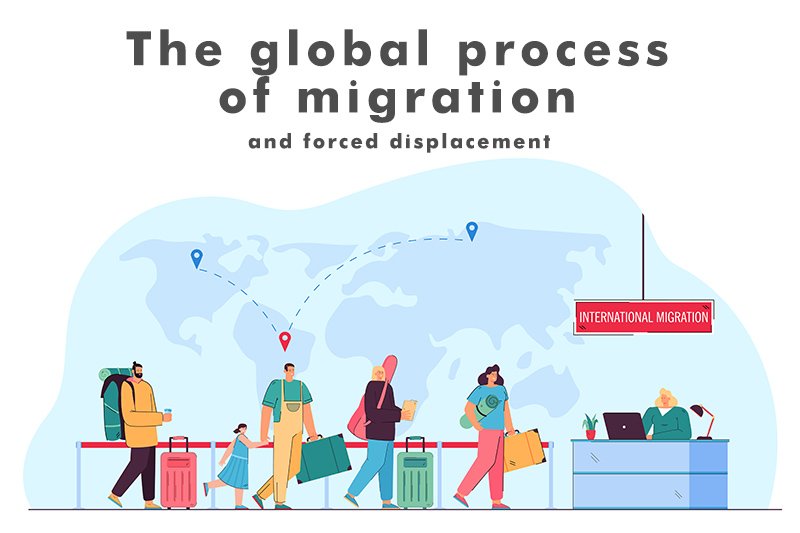Migrants - bringing with them new ideas, unique knowledge and specific skills, as well as a sense of entrepreneurship often make a significant socioeconomic and cultural contribution to the places of destination. Not surprisingly, some of the most innovative and successful entrepreneurs have a migration background. Prominent Swiss examples are Henri Nestlé, Julius Maggi or Carl Heinrich Knorr. In fact, about one fifth of the largest Swiss companies were founded by entrepreneurs of foreign origin. Numerous Swiss women with a migrant background are active in the startup scene, and others such as Martina Hingis, Sibel Arslan and Melinda Nadj Abonji are key figures in the cultural, social and political life of Switzerland. Migrants can also have a significant positive impact on their communities and countries of origin, most notably by sending remittances to their families. In this way, money is often channeled into education, nutrition, health or the local private sector. All of the above is necessary to achieve the goals of sustainable development.
Migration also carries risks and challenges that can threaten the achievement of the 2030 Agenda. Uncertain, irregular migration and forced displacement entail significant hardships. People on the move are often exposed to exploitation, abuse and discrimination. In recent years, persecution, conflict, violence and natural disasters have led to a sharp increase in forced displacement and put significant pressure on host governments and communities. This is especially true for low- and middle-income countries, where the vast majority of forcibly displaced persons found refuge. Switzerland is making efforts to address the root causes as well as the consequences of forced displacement and irregular migration through a strategic link between international cooperation and migration policy.
Switzerland was one of the first countries to address the issue of migration and development. Therefore, the Swiss Agency for Development and Cooperation established the Global Migration and Development Program in 2011. The program launched several innovative projects aimed at increasing migration for sustainable development, and spearheaded several global initiatives on migration and development. The program's initial focus was on labor migration, but, in order to respond to changing trends and needs, over time its areas of action were expanded to include other types of migration, such as long-term displacement and creating durable solutions for forcibly displaced persons. As part of SDC's reorganization efforts in 2021, the program has been renamed the Global Program on Migration and Forced Displacement (GPMFD).
Based on a comprehensive approach that encompasses all forms of human mobility, the GPMFD ensures a coherent engagement on migration within the SDC, together with its partners in the federal administration. It also enables the consistent implementation of the link between humanitarian aid, development and peace in accordance with the Swiss foreign migration policy. The current GPMFD 2022-2025 program framework represents the strategic orientation of SDC's engagement in the field of migration. It is focused on the following three components: (i) safe labor migration, (ii) inclusion and social cohesion for migrants and their host communities, and (iii) the contribution of migrants to the sustainable development of countries of origin.
Migration is extremely important for economic development inside and outside of Switzerland, and it encourages innovation and
entrepreneurship. Switzerland has relied heavily on migrant labor for its economic development over the past 150 years. As a small country with high globalization and specialization
economy, Switzerland has to secure part of its workforce abroad. Every fourth worker on the Swiss labor market is a foreign citizen. Switzerland also boasts impressive
diaspora, with around 750,000 Swiss citizens living abroad. Switzerland is therefore interested in an international migration management system that exploits the productive potential of regular migration and reduces the risks and costs associated with irregular, unsafe and forced migration, on its own territory and around the world.
By sending money and knowledge home, as well as through investment, migrant and diaspora communities make an important contribution to sustainable development. The existence of many families depends on private money transfers made by migrants. The COVID-19 pandemic has shown once again that remittances are a key lifeline for many families and communities around the world. Although they are more difficult to quantify, migrants and members of the diaspora also transfer skills, knowledge and know-how, and they become economically active by investing, establishing businesses or promoting trade relations.
GPMFD supports migrant and diaspora communities in strengthening their capacities to make better use of their economic and social capital, from policy advocacy to skills and knowledge transfer, entrepreneurship and philanthropic engagement.
It is very significant to mention that SDC recognized i-diaspora as a prominent partner, and besides i-diaspora, there are also AFFORD, ADEPT, CSOs, GIZ, GK Partners, ILO, IOM, Swisscontact, UNCDF.
Become a member of our network!
Note: Copying parts or the entire text is allowed with the obligatory citation of the source.

